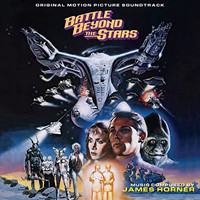- Composed by James Horner
- BSX / 71m (score 43m)
It’s extraordinary really that James Horner – a gentle, shy man – began his film music career by working for Roger Corman. But that was his route into the mainstream and the film that really did it for him was Battle Beyond the Stars – it directly led to him being hired for Star Trek II and the rest was history.
Horner was only 26 when he scored the film and obviously the music budget was tiny, but that didn’t stop him being able to hire a 60-piece orchestra (under the baton of David Newman, no less). His expansive main theme is great: big and bold and with exactly the kind of nautical feel to space that Nicholas Meyer was looking for when he did Star Trek shortly afterwards.

While later in his career he went back far further into musical history for inspiration, in his earlier scores in particular Horner’s admiration from Jerry Goldsmith is very clear. In the second cue, “Malmori Rear Guard”, we clearly hear the (frankly rather hilariously undisguised) influence of Star Trek: The Motion Picture‘s “Klingon Battle”; and in the following “The Battle Begins” we even hear the blaster beam, the distinctive sound Goldsmith used to such great effect in his score, combined with some brilliant brassy action music (some of which would be lifted verbatim into Horner’s own Star Trek scores, some into Krull and some into Aliens).
“Nanelia and Shad” includes the a drastically-rearranged romantic version of the main theme before “Cowboy and the Jackers” includes a trademark early-career Horner extended brass fanfare which is pure dynamite, although it proves too much for the poor soloist who can’t come close to keeping up (one assumes there was not the budget for retakes).
There’s darker action material in “Nanelia’s Capture”, which features some furious writing for the strings and brass and blaster beam. “The Maze Battle” has a militaristic feel to begin with before going into “The Klingon Battle” again – and we almost hear the theme from Krull at one point. It’s all very exciting and so is “Shad’s Pursuit” which follows. The blaster beam comes back, along with the fanfare theme, in the wonderful “Cowboy’s Attack”.
In “Love Theme” we get a series of embellished romantic ideas, opening with full-on “Ilia’s Theme” stylings. It’s lovely, although never quite sweeps and swoons away as you expect it to. “Klingon Battle” is back in “The Hunter” (being heard far more often in this score than the one for which it was written!) – perhaps the most overt version of all, this time.
“Gelt’s Death” is as cheerful as you would expect – a lonesome sound, overwhelmingly sad of course. Then the love theme gets another airing in “Nanelia”, there’s a brief burst of action in “Heading for Sador” and then there’s one last action blowout in “Destruction of Hammerhead”. The wonderful main theme brings things to a close for the end titles.
The score was first released on CD by GNP Crescendo who paired it with the other very early Horner score Humanoids from the Deep; BSX re-released it on its own a few years later but added over half an hour of sound effects by Alan Howarth (to satisfy the enormous global demand for sound effects from Battle Beyond the Stars) and reordered the tracks for some reason (the previous order worked better as a listening experience). That sold out too but it’s available digitally and should be in any Horner collection – it’s unrefined, the orchestral performance is seriously impaired, but it’s so much fun – and fascinating to hear the origins of so many all-time-classic scores that would follow from this composer over the proceeding few years.
Rating: ****
facebook.com/moviewave | twitter.com/MovieWaveDotNet | amazon.com












I loved the score even before I knew it was “Battle beyond the stars” because the music was also used for the tremendously unsuccessful “Wizards of the Lost Kingdom”. I couldn’t believe that James Horner would contribute music to a movie so bad. Anyway, great score from Horner’s early days which I personally prefer to his later works which are of course more mature and refined, but also kind of melancholic.